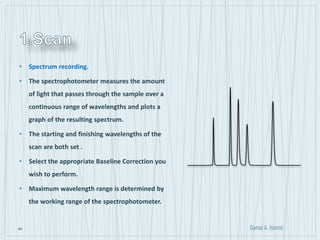
What important information can you gain from a UV-Vis spectrum?
UV-vis spectroscopic data can give qualitative and quantitative information of a given compound or molecule. Irrespective of whether quantitative or qualitative information is required it is important to use a reference cell to zero the instrument for the solvent the compound is in.
How does UV-Vis measure concentration?
A UV/VIS spectrophotometer measures the intensity of light passing through a sample solution in a cuvette, and compares it to the intensity of the light before it passes through the sample.
How is absorbance measured in UV-Vis?
With UV-Vis spectroscopy, the UV-Vis light is passed through a sample and the transmittance of light by a sample is measured. From the transmittance (T), the absorbance can be calculated as A=-log (T). An absorbance spectrum is obtained that shows the absorbance of a compound at different wavelengths.
Why is UV-Vis spectroscopy important?
UV-VIS spectroscopy, like FTIR, is a technique which is useful in the identification of pure drug compounds. Many molecules contain chromophores which will absorb specific wavelengths of ultra violet or visible light.
Why is UV spectroscopy used?
UV–visible spectroscopy is routinely used in analytical chemistry for the quantitative determination of analytes, such as transition metal ions, highly conjugated organic compounds, and biological macromolecules. UV–visible is used to determine the size and concentration of NPs.
What type of samples can be measured by UV-Vis?
UV/Vis spectroscopy is routinely used in analytical chemistry for the quantitative determination of diverse analytes or sample, such as transition metal ions, highly conjugated organic compounds, and biological macromolecules.
What does absorbance tell?
Absorbance (A), also known as optical density (OD), is the quantity of light absorbed by a solution. Transmittance is the quantity of light that passes through a solution.
How do you read UV-Vis spectroscopy?
1) Step 1: Identify the number of peaks appearing in the UV-VIS spectrum. Figure 5 shows several peaks indicating the presence of an excited electron. The easier the electrons are excited, the greater the wavelength that is absorbed, the more electrons are excited, the higher the absorbance.